Excerpts from Jim Conrad's
Naturalist Newsletter
from the November 9, 2014 Newsletter issued from Río Lagartos, on the Yucatan Peninsula's northern coast (~N21.60°, ~W88.16°), Yucatán state, MÉXICO
LUFFA THE VEGETABLE SPONGE
Down the street a house has been torn down leaving an open space with some trees at the back of the lot absolutely smothered in vines, as shown below:
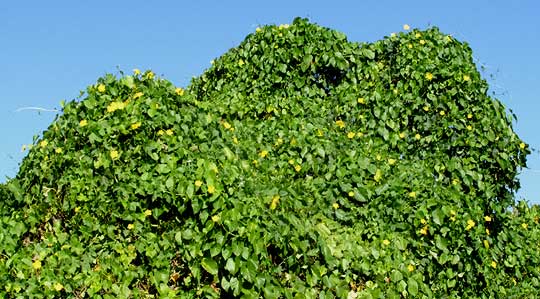
Up in Mississippi this is how Kudzu grows over things, but this isn't Kudzu. The vine produces fair-sized yellow flowers, one of which is shown below:
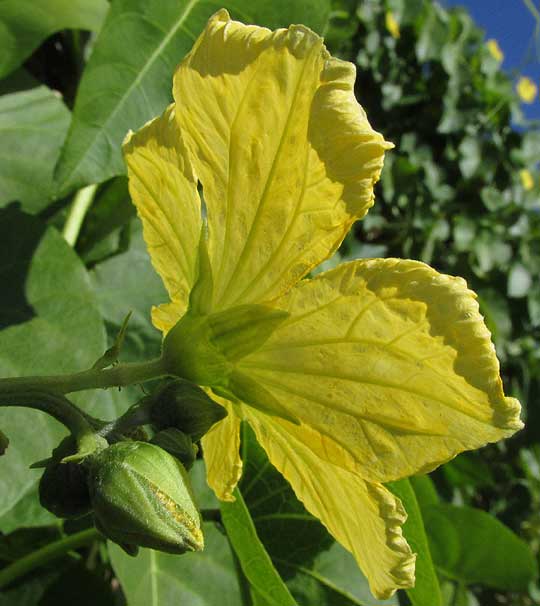
Just with the plant's viney nature and the large, yellow flowers, already we're thinking in terms of this being a member of the Squash/Gourd/Cucumber Family, the Cucurbitaceae. However, that's a big, complex family, so to know exactly what this is we need to pay attention to field marks. Two important features to notice in the last picture are that the corolla is divided into five very deeply divided lobes, unlike the flowers of garden squashes and gourds, plus several flower buds arise from the same stem as the open blossom. You might remember that in most other members of the family there's just one blossom per flower stem.
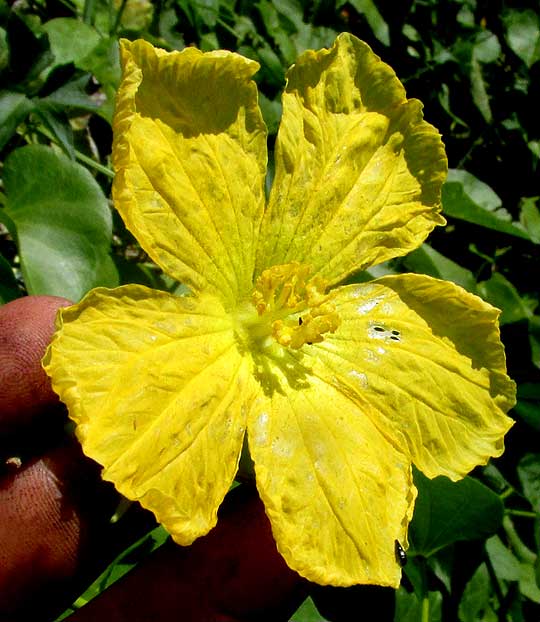
Above we see the flower's face, which doesn't tell us much , until we take a closer look at the bundle of yellow items in the blossom's center, shown below:
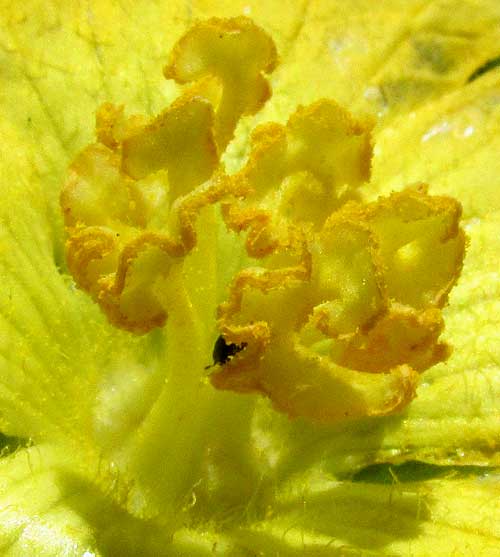
That's a cluster of stamens doing funny, frilly things with their pollen-producing anthers. Mainly, the anthers are "sigmoid," an amazing term meaning "curved like a C," or "crescent-shaped." Also they're flexible, so normally in botanical literature they're described as "sigmoid-flexuous." Maybe the most important point to notice about the stamens, however, is that this blossom contains no female parts. This is a unisexual male flower, for members of the Squash/Gourd/Cucumber Family always produce unisexual flowers.
Unlike the leaves of common squash and cucumber vines, this vine's leaves are somewhat star-shaped, as shown below:
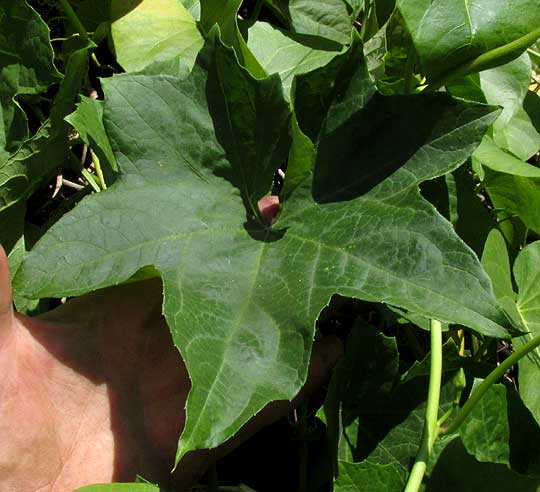
And while I was rearranging stems for the above picture something heavy bumped against me, the thing shown in my hand (dirty from gardening) shown below:
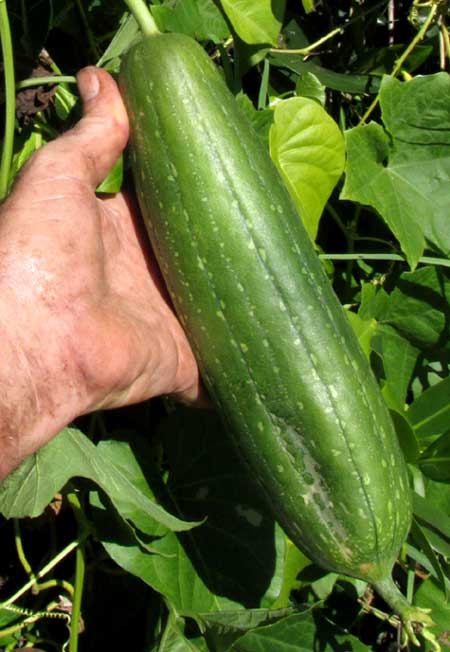
So, now we've seen all we need to know what we have. When the fruit shown in the last picture matures, it can be broken open, its contents removed, cleaned and dried, and then you'll have something like a sponge, or at least a nice, scratchy rag. This vine and its fruit are often called Vegetable Sponge, Dishcloth Gourd, Dishrag Gourd, Rag Gourd, Sponge Gourd and a host of other names. It's LUFFA CYLINDRICA.
Vegetable Sponge has served humanity for so long, and has been spread across the warmer parts of the entire world so effectively, that it's hard to say where the wild ancestor lived, though it's assumed to have been in Africa or Asia. A similar species of the same genus and with many of the same features sometimes is encountered, Luffa acutangula, but its long fruits are more distinctly ribbed and angled than our Río Lagartos one.
Not only can you make a good washrag from the mature fruit's fibrous interior -- its "endocarp," in botanical terms -- but also the young fruit can be eaten fresh or cooked as a vegetable, especially in countries where cultivars have been developed with eating in mind. The roasted seeds are edible and contain an oil that is both edible and serviceable in the manufacture of soap. Goats crave the fruits and leaves, and bees feed on the flowers.
To top it off, it's medicinal. Root preparations are taken for the treatment of constipation and as a diuretic, and in Gabon it's used for nose cancer. In Tanzania a root decoction and the leaf sap are drunk to reduce the danger of abortion. Well, such uses just go on and on.
For a long time in human history Luffa gourd has been a cherished neighbor around people's homes and it's a shame it's not grown more nowadays, if only in gratitude.
from the February 8, 2015 Newsletter issued from Río Lagartos, on the Yucatan Peninsula's northern coast (~N21.60°, ~W88.16°), Yucatán state, MÉXICO
LUFFA GOURD PRODUCING ITS SCRUBBING PADS
Now well into the dry season, the big heap of vines is looking bug-eaten and its leaves are drying up. Most of its gourds already are past the time when they should have been picked, if I'd wanted to harvest their sponges. However, plenty of gourds, surprisingly light and fragile, remain dangling from the vines, such as the one shown below:
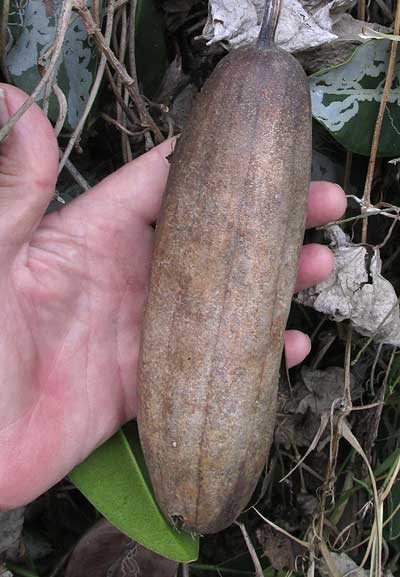
If you turn around that gourd you see that the shell's back part has been shattered by an animal and the gourd's seeds removed, probably to be eaten. This has exposed the gourd's intricate network of stiff fibers, as shown below:

The network of fibers, which are the fruit's dried-up vascular system consisting of xylem and phloem bundles, is still intact enough to be used as a kind of scratchy rubbing pad, though it's hard to see that it would have much value as a sponge. Below, you can see the fibers removed from the gourd:
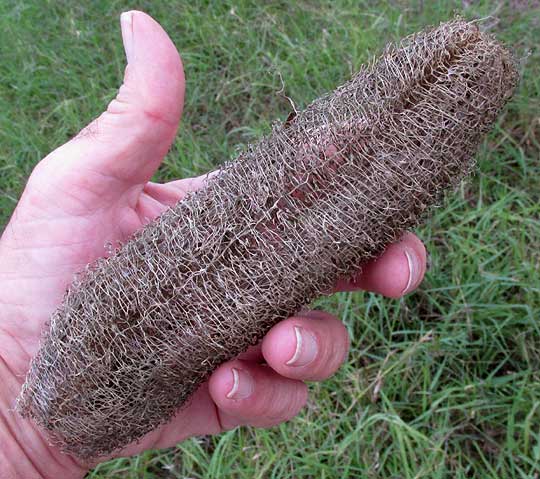
Here it doesn't appear that anyone is using this important plant. It's just a weedy vine ignored by everyone.